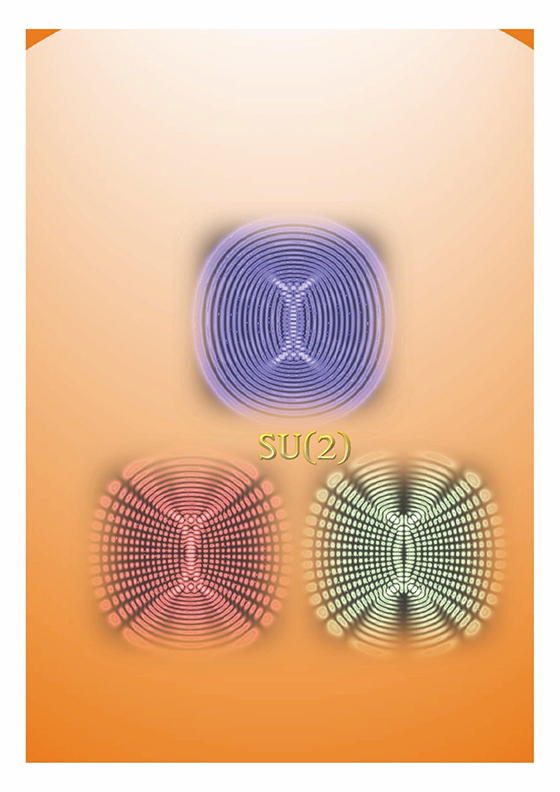The quantum harmonic oscillator is an indispensable example for understanding the quantum classical correspondence, quantifying the concepts of radiation fields and quantum optics. The eigenmodes of two-dimensional (2D) quantum harmonic oscillators can be resolved into Hermite-Gaussian (HG) modes with rectangular symmetry or Laguerre-Gaussian (LG) modes with circular symmetry. Since the paraxial wave equation of the spherical laser cavity is the same as the Schrödinger equation of the two-dimensional harmonic oscillator, the HG and LG eigenmodes play important roles in the exploration of laser transverse modes. With the advent of end-pumped configurations, high-order HG and LG modes can be efficiently generated in diode-pumped solid-state lasers. The Ince-Gaussian (IG) mode is another eigenfunction form of the paraxial wave equation, which has recently been introduced, and it has also been experimentally observed in a stable cavity.
The general form that characterizes scalar monochromatic light waves is a complex-valued function, which can be expressed as real and imaginary parts. The intersections of the nodal lines of the real and imaginary parts are all isolated zeros, the so-called phase singularities. Since singularities are surrounded by cyclic phases, they are usually related to the formation of optical vortices. Therefore, the terms phase singularity and optical vortex are often used interchangeably. Optical vortex beams carrying orbital angular momentum (OAM) can be used in various fields, including optical tweezers, trapping and guiding cold atoms, radio communications, and quantum information processing. Several techniques have been proposed to generate optical vortex beams. One approach with an astigmatic mode converter (AMC) has been widely used to generate the optical vortex beams which are associated with the so-called Hermite-Laguerre-Gaussian (HLG) beam. The HLG beam is a continuous evolution between the HG and LG beams, which can be achieved continuously by rotating the AMC around the optical axis by an angle.
On the other hand, the ellipse is a classic periodic orbit in a 2D isotropic harmonic oscillator. The SU(2) coherent state has been used to prove the quantum wave function localized on an elliptical orbit. It is generally found that quantum wave functions localized on classical periodic orbits are related to striking quantum phenomena, such as the conductance fluctuations of mesoscopic semiconductor billiard balls, the oscillation of light separation cross-sections, and the shell effect in metals in the cluster. In laser physics, diode-pumped solid-state lasers have been experimentally used to observe the elliptical mode corresponding to the SU(2) coherent state. Mathematically, the SU(2) ellipse mode is the superposition of the degenerate HG mode. Recently it was verified that the ellipse mode and the HG mode can form a quantum Fourier transform pair. According to the representation of the quantum coherent state, the elliptical mode as the integral of the two-dimensional Gaussian wave packet on the elliptical orbit was creatively derived, without involving the HG mode. The derived integral formula can be widely used to calculate not only the elliptical mode but also the HLG mode in an ultra-efficient way.
Recently, a research group led by Prof. Yongfu Chen from Taiwan Chiao Tung University published a review in Chinese Optics Letters Volume 18, No. 9, 2020 (Yongfu Chen, et al. Laser transverse modes of spherical resonators: A review).In this review article, Schwinger's SU(2) transformation is used to systematically outline the wave representation of the HLG transverse mode of a spherical laser resonator. The SU(2) representation of the HLG mode means that the HG mode and the LG mode are analytically connected through the rotation transformation on the Poincaré sphere. On another topic, the wave representation of elliptic modes by extending the one-dimensional (1D) Schrödinger coherent state to the 2D coherent state is reviewed. The integral formula of the ellipse module is obtained based on the integral of the Gaussian wave packet on the ellipse trajectory. Quantum Fourier transform is further reviewed to decompose the HG mode into coherent superpositions of elliptical modes corresponding to a bunch of elliptical orbits. It is also outlined that the decomposition of the HG mode can be extended to represent the HLG mode as a coherent superposition of the elliptical modes corresponding to the elliptical orbital beam under the SU(2) transformation. The overwhelming advantage of expressing the HLG mode based on the ellipse mode is the direct manifestation of the wave-ray (quantum classical) connection without involving the special functions of Hermite and Laguerre polynomials. Finally, it is outlined how to use the wave representation of the HLG mode to characterize the propagation and evolution of the vortex structure of the HG beam converted from a single-angle AMC to an arbitrary-angle. Since in-depth studies on laser modes with orbital angular momentum have been conducted in the past few years, this analysis in the review undoubtedly provides not only teaching insights for quantum physics, but also theoretical formulae for generating optical vortices.

The SU(2) transformation in the Jordan-Schwinger map is exploited to derive the wave function for the Hermite-Laguerre-Gaussian (HLG) modes which are the generalized transverse modes of spherical laser resonators. The image is numerical patterns for the high-order HLG mode.


